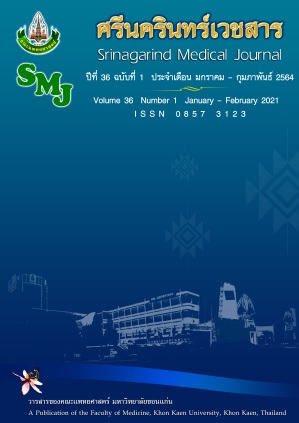Epidemiology of Eye Diseases in Handi-capped Inmates, Ubon Ratchathani Province
Keywords:
handicapped inmate; vision impairment; eye disease; ocular surface disease; prisonAbstract
Background and objectives: Blindness and vision impairment (VI) are a global problem that the causes of the VI are usually preventable. Handi-capped inmate (HI) has their freedom restricted, however, a proper healthcare should not be restricted. Epidemiological study about eye diseases may be useful for planning the effective screening program and comprehensive eye care in HIs.
Methods: A descriptive analysis using a data from questionnaires, refractive values and comprehensive eye exam in HIs at the central prison, Ubon Ratchathani province was done between February - March 2020.
Results: Sixty HIs in this study, which 58 HIs had physical disability (96.67%). Sixteen HIs had distant VI (26.67%), which common causes were cataract and refractive error. HIs whom aged 35 years old and older had near VI about 18 cases (39.1%). Dry eye symptoms were commonly found which compatible with ocular surface abnormalities e.g. pinguecula, pterygium and abnormal conjunctival and corneal fluorescein staining were 98.33%, 35% and 75%, respectively.
Conclusion: VI and eye diseases were commonly found in HIs which should be received a comprehensive eye care from public health team, prison staff and ophthalmologist. Effective visual acuity testing, eye disease screening in prison and referring to ophthalmologist are necessary. Ocular surface diseases should be concerned in HIs with vision disturbance.
References
2. Saraban J. Medical referral for sick prisoners. Public Health & Health Laws Journal 2018; 4: 267-278.
3. Prabhasawat P, Chirapapaisan C, Chitkornkijsin C, Pinitpuwadol W, Saiman M, Veeraburinon A. Eyeliner induces tear film instability and meibomian gland dysfunction. Cornea 2020; 39: 473-478.
4. Uchino M, Schaumberg DA. Dry eye disease: impact on quality of life and vision. Curr Ophthalmol Rep 2013; 1: 51-7.
5. The impact of myopia and high myopia: report of the Joint World Health Organization–Brien Holden Vision Institute Global Scientific Meeting on Myopia, University of New South Wales, Sydney, Australia, 16–18 March 2015: ISBN 978-92-4-151119-3.
6. Alrashidi SH. Pattern of refractive errors in Buraydah. How serious is the problem? Int J Health Sci 2018; 12: 39-41.
7. ICD-11 (foundation). Vision impairment including blindness [monograph on the Internet]. World Health Organization; 2020 [cited April 3, 2020]. Available from: https://icd.who.int/dev11/f/en.
8. Gilbert C, Jackson ML, Kyari F, Naidoo K, Rao GN, Resnikoff S, West S. World report on vision. Switzerland: World Health Organization; 2019. ISBN 978-92-4-1516570.
9. Zhong J, Tan Y, Li S, Peng L, Wang B, Deng Y, et al. The prevalence of demodex folliculorum and demodex brevis in cylindrical dandruff patients. J Ophthalmol 2019; 2019:8949683. doi: 10.1155/2019/8949683.
10. Siramon S, Udomsuk L, Wongwibulsin T. Update in demodex blepharitis. Srinagarind Med J 2020; 35(2): 224-231.
11. Maheshwari S. Pterygium induced corneal refractive changes. Indian J Ophthalmol. 2007;55:383-6.
12. Bron A, Evans VE, Smith JA. Grading of corneal and conjunctival staining in the context of other dry eye tests. Cornea. 2003; 22: 640-50.
13. Leo T, Chylack JR, Wolfe JK, Singer DM, et al. The lens opacities classification system III. Arch Ophthalmol 1993; 111: 831-836.
14. Prata TS, Dorairaj S, Trancoso L, Kanadani FN, Biteli LG, Furlanetto R, et al. Eyes with large disc cupping and normal intraocular pressure: using optical coherence tomography to discriminate those with and without glaucoma. Med Hypothesis Discov Innov Ophthalmol 2014; 3: 91-98.
15. Ackland P, Resnikoff S, Bourne R. World blindness and visual impairment: despite many successes, the problem is growing. Community Eye Health 2017; 30: 71–3.
16. Craig JP, Nelson JD, Azar DT, Belmonte C, Bron AJ, Chauhan SK, et al. TFOS DEWS II report executive summary. Ocul Surf 2017; 15 (4): 802-812.
17. Vongkittirux S. Prevalence of ocular health and common eye diseases in elderly from seniors club Thammasat university hospital. Thammasat Thai Journal of Ophthalmology. 2009; 4 (1): 57-65.




